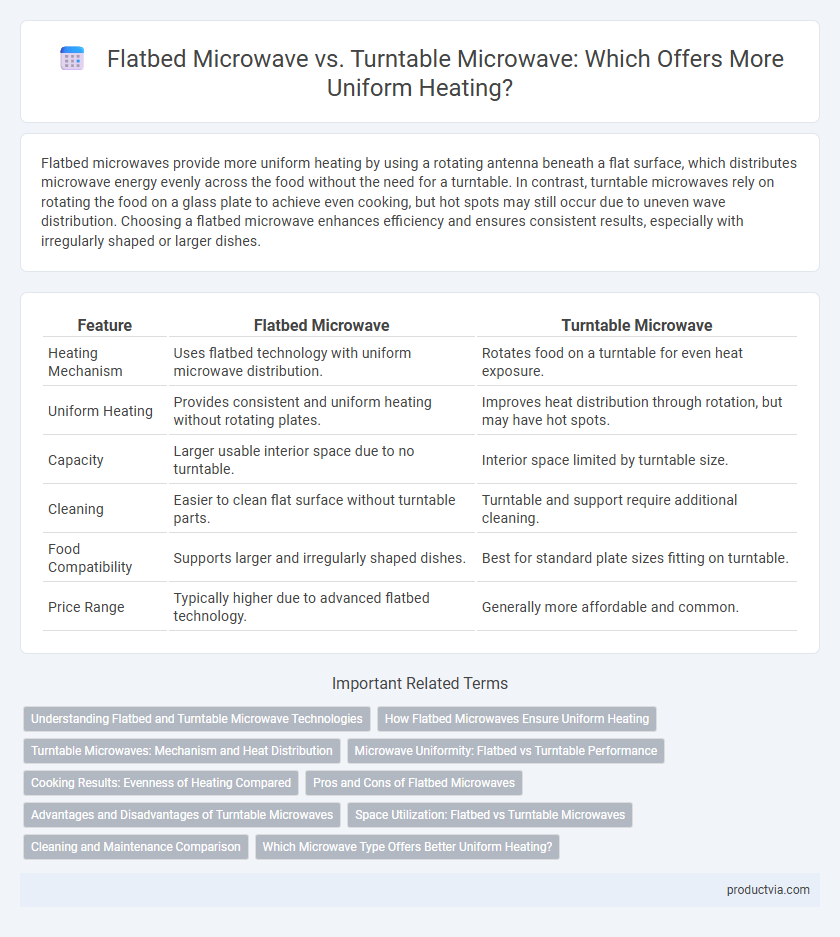Flatbed microwaves provide more uniform heating by using a rotating antenna beneath a flat surface, which distributes microwave energy evenly across the food without the need for a turntable. In contrast, turntable microwaves rely on rotating the food on a glass plate to achieve even cooking, but hot spots may still occur due to uneven wave distribution. Choosing a flatbed microwave enhances efficiency and ensures consistent results, especially with irregularly shaped or larger dishes.
Table of Comparison
| Feature | Flatbed Microwave | Turntable Microwave |
|---|---|---|
| Heating Mechanism | Uses flatbed technology with uniform microwave distribution. | Rotates food on a turntable for even heat exposure. |
| Uniform Heating | Provides consistent and uniform heating without rotating plates. | Improves heat distribution through rotation, but may have hot spots. |
| Capacity | Larger usable interior space due to no turntable. | Interior space limited by turntable size. |
| Cleaning | Easier to clean flat surface without turntable parts. | Turntable and support require additional cleaning. |
| Food Compatibility | Supports larger and irregularly shaped dishes. | Best for standard plate sizes fitting on turntable. |
| Price Range | Typically higher due to advanced flatbed technology. | Generally more affordable and common. |
Understanding Flatbed and Turntable Microwave Technologies
Flatbed microwave ovens use a rotating antenna beneath a flat surface to distribute microwaves evenly, eliminating the need for a turntable and promoting uniform heating across the entire cavity. Turntable microwaves rely on a rotating glass plate that moves food through the microwave energy, which can create uneven heating due to fixed wave patterns and potential food positioning issues. Understanding these technologies highlights the flatbed microwave's advantage in providing consistent cooking results and maximizing interior space without rotating parts.
How Flatbed Microwaves Ensure Uniform Heating
Flatbed microwaves ensure uniform heating by eliminating the need for a rotating turntable, using advanced flatbed technology that distributes microwave energy evenly across the entire cavity. This design enables consistent cooking and defrosting of larger or irregularly shaped dishes without hotspots or cold zones. Sensors and multiple wave sources work together to maintain even heat distribution, providing superior performance compared to traditional turntable microwaves.
Turntable Microwaves: Mechanism and Heat Distribution
Turntable microwaves use a rotating glass plate to evenly expose food to microwave radiation, enhancing uniform heating by reducing cold spots. The rotation mechanism ensures consistent kinetic energy distribution, improving cooking performance for various food shapes and sizes. This design contrasts with flatbed microwaves, which rely on a rotating antenna, but turntables remain popular for their proven efficiency in heat distribution.
Microwave Uniformity: Flatbed vs Turntable Performance
Flatbed microwaves offer superior uniform heating compared to turntable models by utilizing a rotating antenna underneath the flat surface to distribute microwaves evenly across the cooking cavity. Turntable microwaves rely on a rotating plate to move food through microwave beams, often causing uneven cooking in larger or irregularly shaped dishes. Consumers seeking consistent heat distribution and improved cooking performance benefit from the advanced uniformity provided by flatbed microwave technology.
Cooking Results: Evenness of Heating Compared
Flatbed microwaves deliver more uniform heating by utilizing a flat, rotating plate that evenly distributes microwaves across the food surface, reducing cold spots compared to turntable models. Turntable microwaves rely on a rotating glass tray to move food through fixed microwave waves, which can cause uneven cooking, especially with irregularly shaped dishes. The advanced wave distribution technology in flatbed microwaves ensures consistent cooking results, making them ideal for thorough and even heating.
Pros and Cons of Flatbed Microwaves
Flatbed microwaves provide more even heating compared to turntable models by eliminating the rotating plate, allowing microwaves to be distributed uniformly across the flat surface. Their spacious interior accommodates larger dishes and simplifies cleaning due to the absence of a turntable mechanism, but they may come at a higher price point and occasionally display uneven heating at certain spots. Consumers benefit from improved versatility and easier maintenance with flatbed microwaves while weighing potential cost and performance trade-offs.
Advantages and Disadvantages of Turntable Microwaves
Turntable microwaves offer the advantage of evenly distributing heat by rotating food during cooking, reducing cold spots and enhancing uniform heating for various dishes. However, their rotating mechanism can limit the size and shape of containers that fit inside, and the turntable may require regular cleaning or maintenance. Despite these drawbacks, turntable microwaves remain popular for their consistent cooking performance and ease of use compared to flatbed models.
Space Utilization: Flatbed vs Turntable Microwaves
Flatbed microwaves offer superior space utilization by eliminating the rotating turntable, providing a larger and more accessible interior cavity for uniform heating of bulky or multiple dishes. Turntable microwaves use a rotating tray to evenly distribute microwaves, but the tray occupies internal space and limits dish size and arrangement flexibility. Flatbed technology enhances even heat distribution while maximizing cooking area, making it ideal for efficient meal preparation and compact kitchen setups.
Cleaning and Maintenance Comparison
Flatbed microwaves offer a spacious interior free of rotating plates, simplifying cleaning by eliminating hard-to-reach edges and crevices where food particles can accumulate. Turntable microwaves feature a rotating glass plate that requires frequent removal and cleaning to prevent buildup beneath the plate, increasing maintenance efforts. The seamless design of flatbed models reduces cleaning time and enhances hygiene, making them more convenient for users prioritizing easy upkeep.
Which Microwave Type Offers Better Uniform Heating?
Flatbed microwaves provide more uniform heating by distributing microwaves evenly across the entire cavity without the need for a rotating turntable, minimizing cold spots. Turntable microwaves rely on a rotating plate to move food through microwave energy, but uneven rotation can cause inconsistent heating. Studies show flatbed models consistently offer better heat distribution for evenly cooked meals.
Flatbed microwave vs Turntable microwave for uniform heating Infographic

 productvia.com
productvia.com